Looking under the Hood: Our Two New Active International ETFs


I previously introduced WisdomTree’s two new active international and emerging market multi-factor ETFs as harbingers of the next frontier in ETFs: modern alpha investment strategies.
Modern alpha strategies take what investors desire from legacy alpha strategies, i.e., the pursuit of outperformance, but marry that goal with the characteristics of ETFs and beta-oriented investment strategies to create a hybrid, next-generation strategy.
In spirit, our new active ETFs are going to take significant active risks. These new ETFs are not going to be benchmark-hugging, low-tracking-error strategies whose top 10 portfolio holdings look like the top 10 portfolio holdings in their respective cap-weighted universes. Who really needs another closet beta-like, active-lite index fund?
No, the active approach will be grounded by a factor model that we believe is supported through academic research.
Innovations in our new active approach include:
- A unique blending of fundamental and technical factors to create a proprietary stock selection and weighting model:
- WisdomTree technical factor screens: Momentum and Correlation
The inclusion of Value, Quality and Momentum as factors in a portfolio will not surprise people. The Low-Correlation factor is new for some people, although we have witnessed other quantitative managers publish on this factor recently as well. This Low-Correlation factor is related to low volatility and the low-beta phenomena.
The metrics we evaluate to create a factor score for each company are listed below. The specific metrics will be common to many similar approaches, but our more active formula for how we apply these factor tilts, we believe, helps set us apart from other publicly disclosed index methodologies.
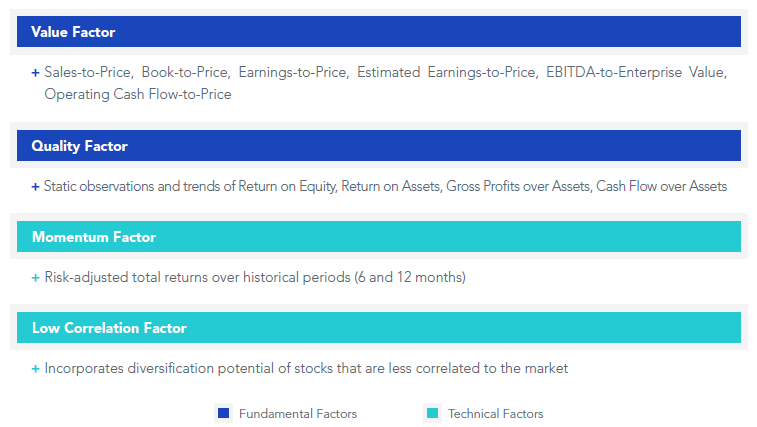
Factor Performance Attribution
Our respective MSCI market-cap benchmarks for developed international and emerging markets can be used to show how WisdomTree’s factor definitions have performed over time. Every company in these benchmarks is given a numerical factor score for each of the fundamental factors (Value and Quality) and technical factors (Low Correlation and Momentum). Once scored, constituents are ranked and assigned to one of three portfolios (Good, OK, Bad) created by dividing each benchmark universe in thirds.
Below we can see that the portfolio of top-value scores (Good) in MSCI EAFE has historically outperformed the portfolio of worst-value scores (Bad) on both an absolute and a risk-adjusted basis. This same trend is present when looking across the rest of the factors in both developed international and emerging markets.
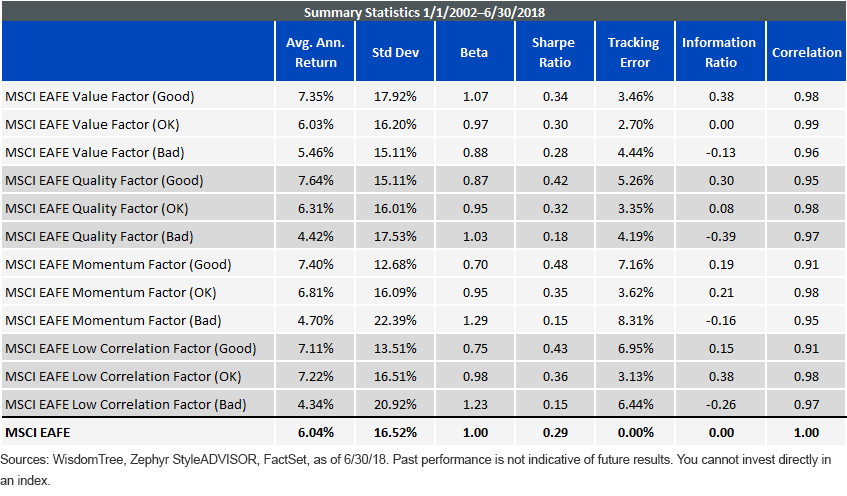
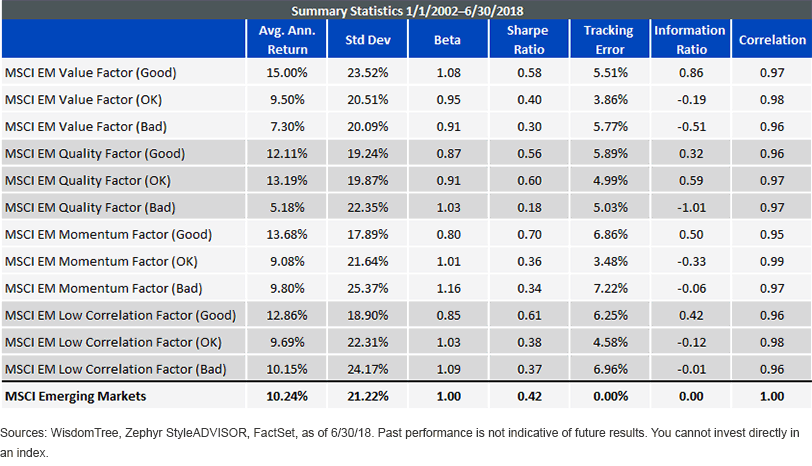
Screening for Our ETFs
To create the portfolios for our international and emerging market multifactor ETFs, the following discipline is applied:
- Active Selection: WisdomTree’s stock selection universe starts with the 800 largest market capitalization stocks in each respective region. From this universe, WisdomTree selects the top 200 stocks with the highest combined factor score. Taking one-quarter of the starting universe—from a stock selection standpoint—is a fairly “active” cut of the universe. We did not find value or additional consistent alpha for going any deeper into more narrow stock selection rules like 100 stocks instead of 200.
- Risk and Return Weighting: WisdomTree utilizes not just a factor score—a stock’s alpha signal—as part of the weighting process but also a stock’s volatility level. This incorporates a concept of risk-adjusted return as a key driver of weights in our portfolios.
- Sector and Country Bands: One of the key potential risks WisdomTree identified in factor investment strategies is how many such strategies wind up with large sector or country bets relative to the market. These bets may help or hurt over given market cycles. WisdomTree, in looking to add stock selection value through a diversified factor selection model, wanted to minimize the risk of diluting our alpha signals as a result of mismatched sector or country weights relative to the market. Yet we also found that our factor models have some implicit signaling in terms of country and sector tilts, so we will allow some constrained deviation on a country and sector basis away from the pure market index.
The initial stock screening process can be summarized with this flow diagram:
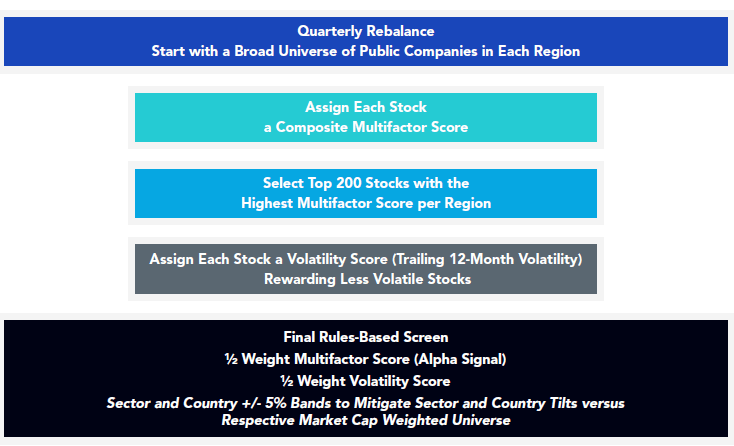
The Currency Factor: A Dynamic and More Active Approach
WisdomTree also believes a factor that impacts international markets is Currency Risk, and many want to leave it to their active manager to make such hedging decisions for them.
In certain Index investment strategies WisdomTree has in the marketplace today, we offer three currency approaches: an unhedged, a fully hedged and a dynamically hedged Index.
In these new international and emerging market active ETFs, we are offering only one investment approach that takes currency risk management as one of the multiple factors we are actively managing. There will be times the Funds will have currency risk, and other times when more of the currencies will be hedged. All those decisions will be grounded in research and a factor model.
Dynamic Currency Overlay: Developed and emerging market currencies exhibit drastically different liquidity, risk and hedging costs. As a result, WisdomTree’s research concluded that a different approach is needed across markets. Hedge ratios for developed markets will be set on a monthly basis, and emerging markets will be re-evaluated every two weeks.
- Developed Markets: For any individual currency, hedge ratios can be adjusted between 0% and 100% based on the degree of the results of three signals: Carry (interest rate differentials or the cost to hedge), Momentum and Value (purchasing power parity).
- Emerging Markets: Three Momentum factors are used to determine degree in conviction of hedged or unhedged decision for emerging markets.
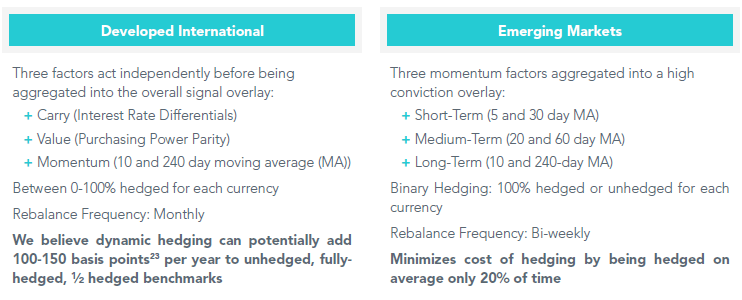
These two new active ETFs, the WisdomTree International Multifactor Fund (DWMF) and the WisdomTree Emerging Markets Multifactor Fund (EMMF), come at an interesting time for international equities. The dollar has broadly strengthened against most major currencies in 2018, with emerging market currencies having come under particular pressure. Our currency hedging signals at the launch of EMMF are largely on, so that the aggregate hedge ratio today is 70%. While we do believe emerging markets have higher interest rates that make strategic hedging more problematic, we expect these more active hedges to only be hedged 20% of the time. We think this active risk management will lead to a smoother ride, which means that investors can stick with emerging markets longer and with more conviction, knowing that one of the big risks is reduced. We do believe emerging markets are a compelling long-run asset class with reasonable valuations. This new ETF is a great solution for timely exposure.
Important Risks Related to this Article
Hedging can help returns when a foreign currency depreciates against the U.S. dollar, but it can hurt when the foreign currency appreciates against the U.S. dollar.
Investing involves risk, including possible loss of principal. Investments in non-U.S. securities involve political, regulatory and economic risks that may not be present in U.S. securities. For example, foreign securities may be subject to risk of loss due to foreign currency fluctuations, political or economic instability or geographic events that adversely impact issuers of foreign securities. Derivatives used by the Funds to offset exposure to foreign currencies may not perform as intended. There can be no assurance that the Funds’ hedging transactions will be effective. The value of an investment in the Funds could be significantly and negatively impacted if foreign currencies appreciate at the same time that the value of the Funds’ equity holdings falls. While the Funds are actively managed, the Funds’ investment process is expected to be heavily dependent on quantitative models and the models may not perform as intended.
Additional risks specific to EMMF include but are not limited to emerging market risk. Investments in securities and instruments traded in developing or emerging markets, or that provide exposure to such securities or markets, can involve additional risks relating to political, economic or regulatory conditions not associated with investments in U.S. securities and instruments or investments in more developed international markets.
Please read the Funds’ prospectuses for specific details regarding the Funds’ risk profiles.

Jeremy Schwartz has served as our Global Chief Investment Officer since November 2021 and leads WisdomTree’s investment strategy team in the construction of WisdomTree’s equity Indexes, quantitative active strategies and multi-asset Model Portfolios. Jeremy joined WisdomTree in May 2005 as a Senior Analyst, adding Deputy Director of Research to his responsibilities in February 2007. He served as Director of Research from October 2008 to October 2018 and as Global Head of Research from November 2018 to November 2021. Before joining WisdomTree, he was a head research assistant for Professor Jeremy Siegel and, in 2022, became his co-author on the sixth edition of the book Stocks for the Long Run. Jeremy is also co-author of the Financial Analysts Journal paper “What Happened to the Original Stocks in the S&P 500?” He received his B.S. in economics from The Wharton School of the University of Pennsylvania and hosts the Wharton Business Radio program Behind the Markets on SiriusXM 132. Jeremy is a member of the CFA Society of Philadelphia.

